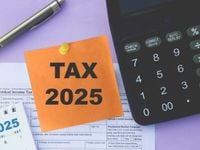As the new financial year 2025-26 begins, significant changes to India’s income tax structure come into effect, aimed at easing the burden on taxpayers. From April 1, 2025, individuals will benefit from new income tax slabs that exempt earnings up to Rs 12 lakh from taxation, a move designed to stimulate economic growth and increase disposable income for the middle class.
The revised income tax slabs under the new tax regime for FY 2025-26 are as follows:
- 0 - 4,00,000: 0%
- 4,00,001 - 8,00,000: 5%
- 8,00,001 - 12,00,000: 10%
- 12,00,001 - 16,00,000: 15%
- 16,00,001 - 20,00,000: 20%
- 20,00,001 - 24,00,000: 25%
- 24,00,001 and above: 30%
In addition to these changes, individuals can claim a tax rebate under Section 87A, which allows for zero tax on income up to Rs 12 lakh, provided they file their income tax returns (ITR). This means that many taxpayers will see a significant reduction in their tax liabilities, potentially keeping more money in their pockets.
Finance Minister Nirmala Sitharaman announced these changes during the February budget, emphasizing the government’s commitment to providing relief to the middle class. The hope is that this extra disposable income will encourage spending, thus driving demand in the economy.
However, there are concerns regarding whether taxpayers will actually spend this additional income. Economic analysts suggest that while lower-income households may be inclined to spend, higher-income earners might save more due to existing financial pressures, such as debt burdens and insufficient safety nets. As noted in a recent report, "the Reserve Bank of India’s (RBI) Financial Stability Report" highlights that many in the middle class are struggling with high debt levels, which may hinder their spending capacity.
Further changes in the budget impact the taxation of unit-linked insurance plans (ULIPs). Now, proceeds from ULIPs that do not qualify for exemption under Section 10(10D) will be treated as capital assets and taxed accordingly. Short-term gains will be taxed at 20%, while long-term gains will face a tax rate of 12.5% without indexation benefits. This change is expected to affect how individuals view these investment products moving forward.
The government has also made adjustments to the tax deduction at source (TDS) rates. For instance, the TDS rate for income payable by securitisation trusts has been reduced from 25% to 10%, effective April 1, 2025. Additionally, the thresholds for various TDS sections have been increased, allowing more individuals to retain a larger portion of their income.
Notably, the previous requirement for higher TDS and tax collection at source (TCS) for non-filers of ITRs has been removed. This change aims to alleviate the compliance burden on taxpayers who may have missed filing their returns in previous years.
Another significant highlight of this budget is the introduction of deductions for contributions to the NPS Vatsalya scheme under Section 80CCD. This deduction is available only for those opting for the old tax regime, which may influence taxpayers’ decisions regarding their tax strategy.
Moreover, the budget has increased the limits for tax-free perquisites related to medical treatments for employees. Effective April 1, 2025, employees will benefit from enhanced tax-free allowances for medical expenses incurred abroad.
In a bid to simplify tax compliance, the calculation of annual value for self-occupied properties has been streamlined. Taxpayers can now claim the annual value of any two houses as zero, easing the process of filing ITRs.
Furthermore, the deadline for filing updated returns has been extended from 24 months to 48 months after the end of the assessment year, providing taxpayers with more time to rectify any discrepancies in their filings.
As the income tax department prepares to compare current ITRs with previous ones for irregularities, the government is taking steps to ensure compliance while also making the tax process less cumbersome for individuals.
Despite these positive changes, the real test will be whether the middle class, often characterized by its cautious approach to spending, will utilize the tax relief to stimulate economic growth. As one economic expert put it, "the relief was generally meant to ease the burden of India’s middle class, but the extent to which they will spend remains uncertain."
In conclusion, as these tax reforms take effect, their impact on consumer behavior, economic growth, and individual financial health will be closely monitored. The government’s hope is that by putting more money in the hands of taxpayers, it can spur a much-needed boost in consumption, ultimately supporting GDP growth and economic recovery.






